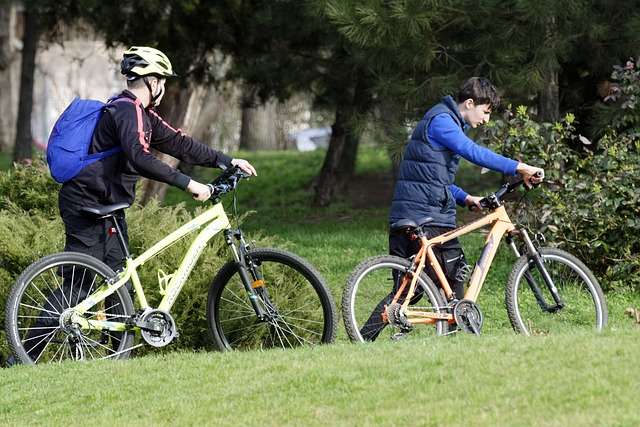
How can a moving bicycle go backwards?
Introduction:
People have known for a long time that bicycles move straight ahead because you pedal them. However, the idea of a bicycle going backward might seem puzzling. In this exploration, we’ll dive into the fascinating world of reversing bicycles to understand how this unexpected feat is achieved.Some bicycles have special features, like a reverse gear or a clever transmission system. Others use a backpedaling mechanism, where pedaling backward engages a brake on the wheel, making it go in the opposite direction. It might sound tricky, and it is! Riding a bicycle backward requires a different set of skills and balance, turning the familiar act of pedaling into a unique and sometimes challenging adventure. Let’s unravel the mechanics and physics behind this unexpected journey into the world of backward cycling.
Explanation:
1. The Basics of Forward Motion:
Before unraveling the mystery of backward motion, it is crucial to grasp the fundamentals of how a bicycle moves forward. A bicycle moves forward mainly because of the rider’s pedaling and the bike’s drivetrain working together.. As the pedals turn, the chain engages with the gears, transferring the rotational energy to the wheels and propelling the bicycle forward.
2. The Role of Gears and Freewheeling:
Gears play a pivotal role in a bicycle’s ability to move forward efficiently. By changing gears, riders can adjust the mechanical advantage, allowing for optimal pedaling efficiency on different terrains. The freewheel mechanism in the rear hub permits the wheel to spin freely when the pedals are stationary, allowing the bicycle to coast without resistance.
3. Reversing the Gears:
To understand how a bicycle can move backward, it’s essential to explore the concept of reversing the gears. In certain specialized bicycles, the design incorporates a reverse gear or a mechanism that alters the direction of the drivetrain. This is often achieved through a unique transmission system that allows the rider to engage reverse motion by manipulating the gear selection.
4. Backpedaling Mechanism:
A more common and straightforward method for achieving backward motion involves the backpedaling mechanism. Traditional bicycles are equipped with a freewheel hub that permits the wheel to rotate in only one direction. However, some designs incorporate a coaster brake or a backpedaling brake hub. When the rider backpedals, the hub engages the brake, causing the wheel to rotate in the opposite direction and effectively moving the bicycle backward.
5. The Counterintuitive Nature of Backward Cycling:
Riding a bicycle backward may seem counterintuitive due to the inherent muscle memory and coordination developed for forward motion. When attempting to ride backward, the rider must overcome the ingrained instinct to pedal in the accustomed direction. This requires a different set of motor skills and balance adjustments, making backward cycling both challenging and intriguing.
6. Specialized Reverse Gear Systems:
In the realm of custom and experimental bicycles, engineers and enthusiasts have developed specialized reverse gear systems. These innovative designs incorporate intricate transmission mechanisms that can be engaged to reverse the direction of the bicycle. While not commonly found on mainstream bicycles, these custom-built creations showcase the versatility and adaptability of bicycle design.
7. Challenges and Considerations:
Riding a bicycle backward presents unique challenges, primarily related to balance and coordination. Since the steering and braking dynamics are different in reverse, riders must adapt to these changes to navigate safely. Additionally, the limited visibility while riding backward requires extra caution and skill to avoid obstacles and maintain control.
8. The Physics of Backward Motion:
The physics of backward cycling involve a complex interplay of forces and torques. When a rider backpedals, the chain engages with the freewheel or coaster brake mechanism, causing the rear wheel to rotate in the opposite direction. This reversal of motion requires the rider to adjust their balance and apply steering inputs in a manner opposite to that of forward motion.
9. Artistic and Recreational Aspects:
Beyond the technical aspects, riding a bicycle backward has found its place in artistic performances and recreational activities. Skilled riders, often seen in circus acts or street performances, showcase impressive backward cycling feats. This unique form of expression adds a creative dimension to the traditional image of cycling and underscores the versatility of bicycles as a medium for artistic expression.
Frequently Asked Questions (FAQs):
Q: Can a bicycle be ridden backward?
A: Yes, it’s possible to ride a bicycle backward using various methods. Some bicycles are designed with a reverse gear, while others utilize a backpedaling mechanism, engaging a brake to make the wheels move in the opposite direction.
Q: What is the backpedaling brake mechanism?
A: The backpedaling brake mechanism is a feature in some bicycles where pedaling backward activates a brake on the rear wheel. This causes the wheel to rotate in the opposite direction, allowing the bicycle to move backward. It requires a different set of skills and balance compared to forward cycling.
Q: Are there bicycles specifically built for backward riding?
A: While not common, there are custom-built bicycles designed for backward riding. These may include specialized reverse gear systems or unique modifications that enable the bicycle to move backward seamlessly.
Q: Is riding a bicycle backward difficult?
A: Yes, riding a bicycle backward can be challenging. The reversed pedaling motion and altered steering dynamics require riders to adapt their coordination and balance. It often takes practice to master the skills needed for safe and controlled backward cycling.
Q: Why would someone want to ride a bicycle backward?
A: Riding a bicycle backward is not only a unique challenge but also a form of artistic expression. Skilled riders showcase backward cycling in performances, adding a creative and entertaining aspect to the traditional image of cycling. Additionally, it serves as an exploration of the adaptability and versatility of bicycle design.
Conclusion:
The ability of a moving bicycle to go backward adds an intriguing layer to the already multifaceted world of cycling. Whether achieved through specialized reverse gears, backpedaling mechanisms, or custom-built innovations, backward cycling showcases the adaptability and creativity within the realm of bicycle design. While not a common feature in everyday bicycles, the pursuit of mastering backward motion adds an element of challenge and fascination for those passionate about pushing the boundaries of traditional cycling. In essence, the journey of a bicycle in reverse unveils a captivating fusion of mechanics, physics, and the adventurous spirit inherent in the world of cycling.

